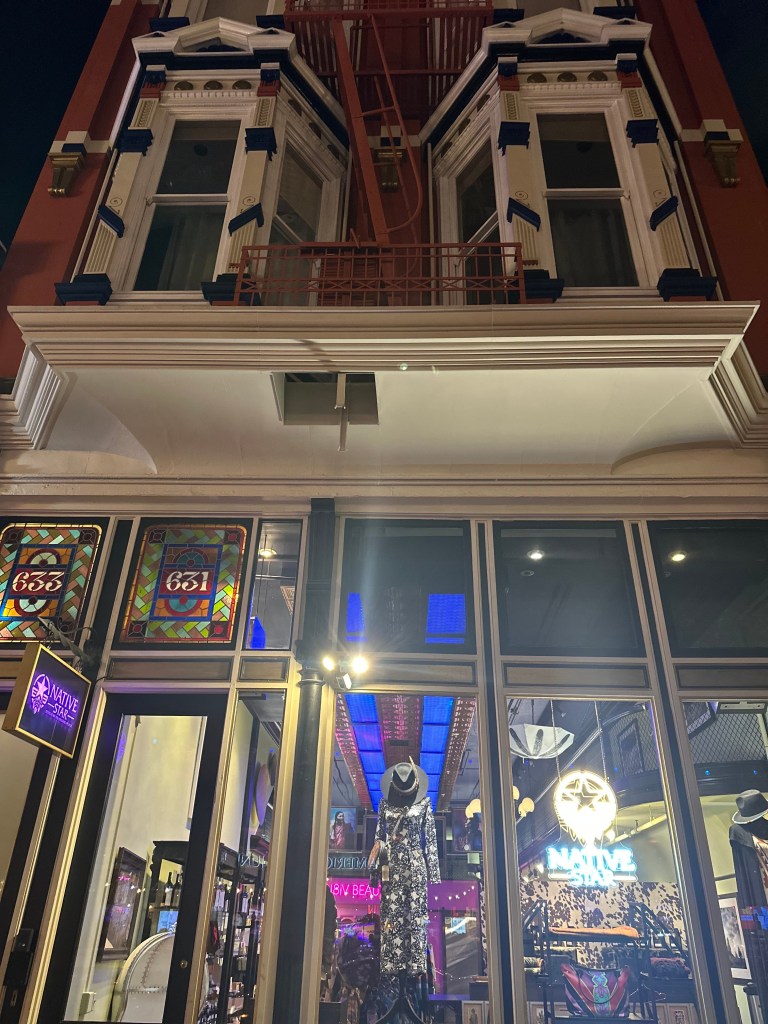Overview: Native Star
One year before to his passing, on April 4, 1882, Capt. Wilcox started work on a massive brick structure that included all the newest amenities, such as large drainage pipes and gas and water fittings.
One of the most recognizable structures in the Gaslamp Quarter and a quintessential example of Victorian architecture is the Yuma Building.
Remarkably, this graceful building at 633 5th Ave., which currently has a historic owner who has created a new store called Native Star, started out as a very simple one-story brick building with a frame front porch.
Capt. Alfred Henry Wilcox, who first arrived in San Diego in 1849 while serving as a mate on the USS Invincible, constructed it. Later on, when he returned as the ship’s captain, he was tasked with mapping the San Diego River and eventually building a dam to try to make a portion of the river into False Baynow Mission Bay.
One year before to his passing, on April 4, 1882, Capt. Wilcox started work on a massive brick structure that included all the newest amenities, such as large drainage pipes and gas and water fittings.
It wasn’t until 1885 that the building was expanded following Captain Wilcox’s passing. His estate was established at that point.
Using the original drawings, his wife, Maria, who inherited the building, was able to begin construction on the existing structure. It presently has a basement and is three floors high.
The walls on the second and third floors are 12 thick, while the stucco over brick walls at street level are 16 thick.
The front was iron-clad, with stained glass over the stairway to the house and two huge bay windows. The upper two storeys were lit by a massive lightwell, sometimes known as a skylight. There were sixteen rooms in the building, and on the ground floor was a store.
The exterior includes enormous plate glass windows that span the front, ornate pilasters, and a flat roof with dentil molding.
Five smaller windows are set in a horizontal line just above the plate glass windows. The upper levels have double-hung sash windows that are made of wood and have ornamental molding around them.
After her stunning renovation was finished, Maria Wilcox moved into her soon-to-be iconic structure.
Notable women involved with the property
The Yuma has been owned or operated by numerous other prominent women over the years.
The upper floors were transformed into furnished rooms in 1901, which were run as the Santa Isabel. The apartments were renamed The Grant in 1912. Mrs. Carrie De Frantz, an African-American woman, was the Grant’s owner. She was one of the first Black businesswomen to hold a managerial position.
Notice was also given to a number of Mrs. De Frantz’s tenants.
Though in a different capacity, these women have left an influence on the economic world.
The Grant became well-known on November 11, 1912, as the final destination of the Great Raid of 1912.
Police Chief Keno Wilson was under growing pressure from a number of civic-minded groups, such as the Ladies Purity League, to clean up the Stingaree, as the neighborhood was known, as the California-Panama Exposition approached San Diego in 1915.
The Stingaree had gained notoriety for its many saloons and related brothels since a large portion of the area’s customer was ephemeral, with many of them being sailors on ships that stopped at the base of Fifth Avenue.
The raid started early on a Sunday morning, and by the end of the day, Keno Wilson had captured 138 women of the night.
Get Downtown News in your inbox community news that connects and informs.
Register to receive breaking news, the Times of San Diego daily at 8 a.m., and free weekly news about Downtown San Diego. Update whenever you want. You acknowledge and agree to the terms by clicking “Sign Up.”
After gathering the women in front of the Grant, Chief Wilson offered them the option to either reform or leave the area. Their train ticket would be covered by the city.
Just two made the decision to change. One became insane, perhaps from a social sickness, while the other became a telegraph operator.
The other women were then told to buy tickets at the Santa Fe Depot after being marched along Fifth Avenue. Since the majority of them bought round-trip tickets and went back the next day, they regrettably did not receive comprehensive instructions. In those days, a girl had to earn a living however she could.
Tough times for San Diego
As a result of the 1950s urban-to-suburban movement, many downtown neighborhoods were abandoned and dilapidated. San Diego was no different.
The once-beautiful structure was in poor shape and required extensive restoration, even though the Grant was still open as furnished rooms. Another female businesswoman and Gaslamp pioneer, Marsha Sewell, and her late husband, Mike Shea, bought the elderly landmark when it became up for sale.
Interior designer Marsha had been searching for a place to run her business that would be convenient to her home. She had both with the restoration.
After Mike’s death in 2001, Marsha remained in the two-story showplace townhouse until 2003, with the upper two stories finished in 1992. This beautifully restored house, which has four fireplaces, has entertained many dignitaries and served as the venue for various civic and cultural events.
The property was once again in turmoil following the COVID lockout.
The historic Yuma needed to be taken up by another industrious woman. Ruth-Ann Thorn, the first Native American to buy land in the Gaslamp, is the new owner.
This is significant because Indians were prohibited from owning land in the 1880s, when the structure was being built and downtown San Diego was being established. If discovered idle, they might be compelled to work as slaves or worse. Even placards declaring that Indians were wanted, either alive or dead, were displayed. $25 per person.
Get neighborhood news in your inbox. It’s free and enlightening.
Become one of the 20,000+ individuals who receive breaking news alerts and the Times of San Diego in their inbox every day at 8 a.m.
Weekly updates from San Diego communities have also been provided! You acknowledge and agree to the terms by clicking “Sign Up.” Choose from the options below.
Native Americans were pushed onto reservations and shunned as a result of the Indian Removal Act and the Dawes Act.
Living on the reservation her family were previously compelled to live on, Ruth-Ann is a Payomkawichum/Luise o and an enrolled member of the Rincon Tribe. Land Back Property Management is the name of her holding firm because, as she says, it’s like reclaiming space that was once ours.
Businesses have come and gone
Over the years, a range of enterprises have also been hosted in the street-level shop.
These have included Goorin Bros. Hat Company, a dry goods business, medical offices, an insurance broker, and a Japanese bazaar. Native Star now calls it home.
This charming store offers an amazing assortment of apparel, headwear, jewelry, art, wine bottled on the reservation, food items, and Ruth-Ann’s brand of beauty goods, N8iV Beauty, all set against a magnificent backdrop of color, lighting, and complex displays.
Black acorn oil, which is gathered on the reservation, is a major component of the cosmetic line.
Everything produced by Indigenous artists in all media is celebrated at this location. It is a sensory delight.
On May 30, Native Star, located at 631 Fifth Avenue, was opened with a drum circle, Bird Singers, and a proclamation by Mayor Todd Gloria.
A feeling of calm and spirituality seemed to drown out the noise and bustle of the Gaslamp’s typical Friday night activities as these sounds reverberated down Fifth Avenue.
It is a tribute to the original inhabitants of this area.

 by
by 

